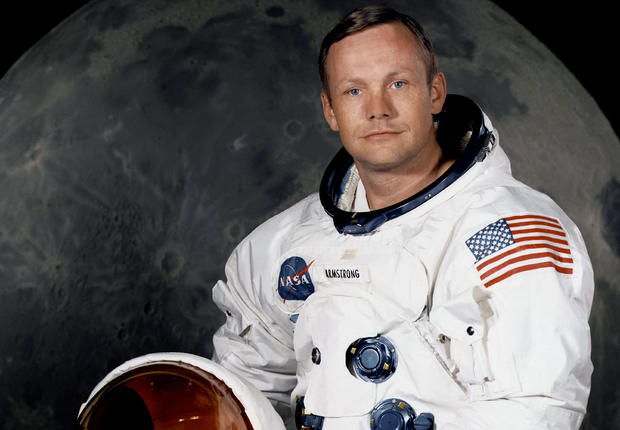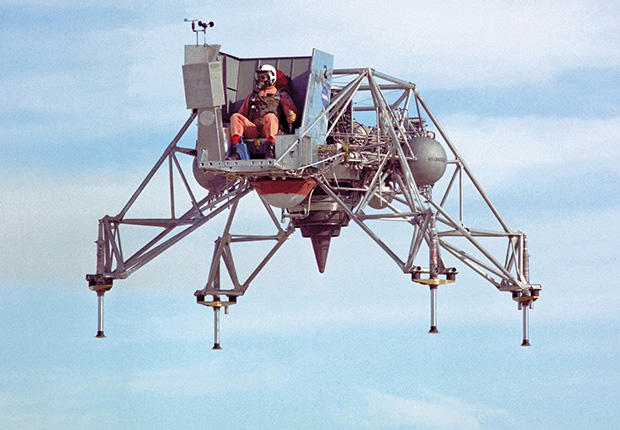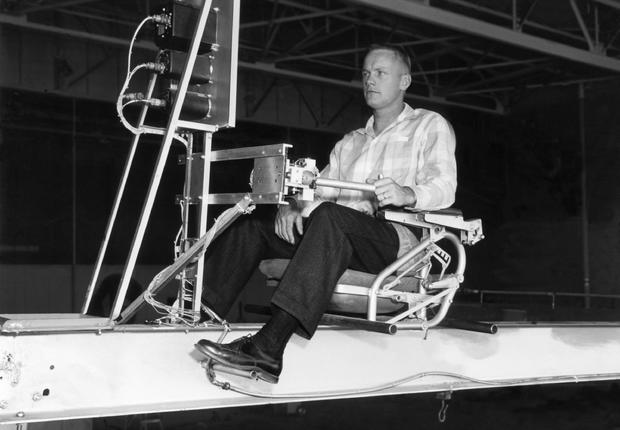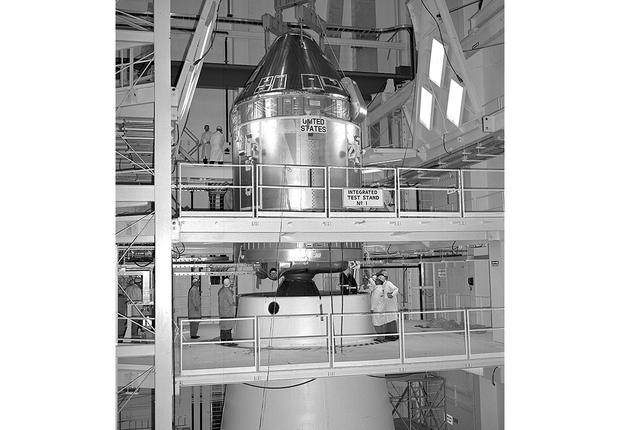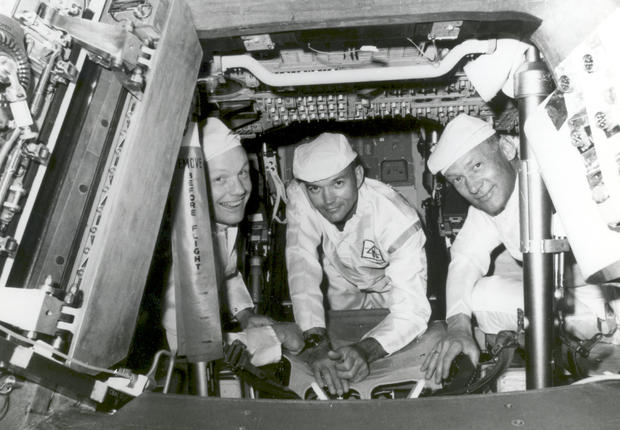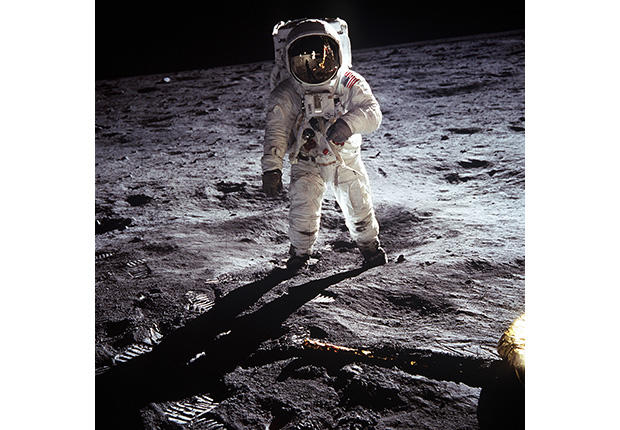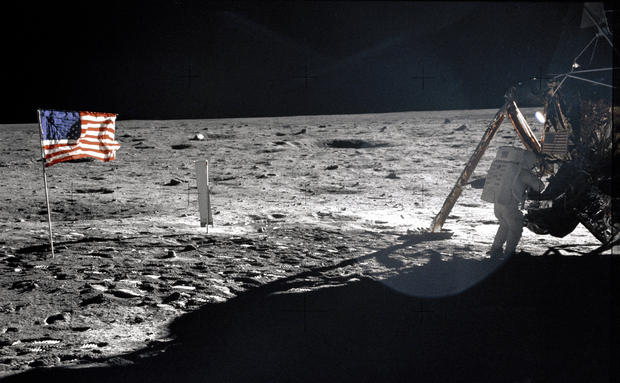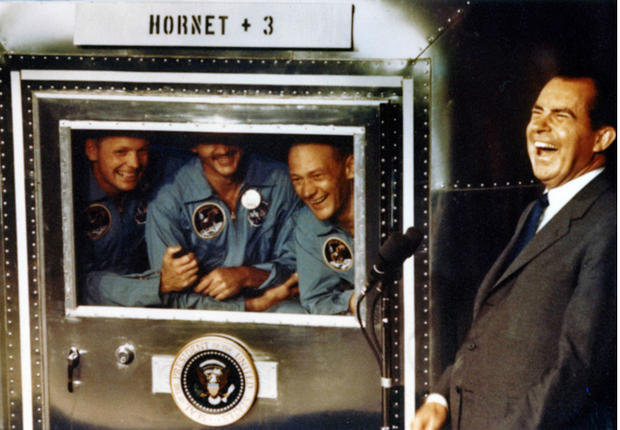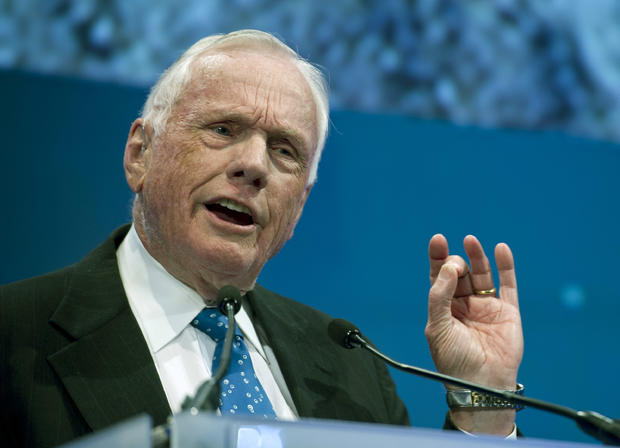The 11 biggest myths about Neil Armstrong, first man on the moon
As the world celebrates the 45th anniversary of the first moon landing made by American spacecraft Apollo 11, on July 20, 1969, the man who took those historic first steps is the subject of renewed fascination. Historian James R. Hansen, author of the only authorized biography of Neil Armstrong, says the iconic Apollo 11 commander is often misunderstood.
As Hansen writes in his New York Times bestseller, "First Man: The Life of Neil A. Armstrong," (Simon and Schuster), Armstrong, because he was such a private and introspective man who was so hard to know, "turned out in later years to be myth personified, an enigma prime to be filled with meaning by others." Armstrong died in 2012, but his legend -- as well as the myths -- live on.
Read on for Hansen's list of the ten biggest myths about Neil Armstrong...
Myth #1
US astronaut Neil Armstrong aboard a simulator practices piloting safely the Lunar Landing Research Vehicle in 1967 two years before Apollo XI space mission launch to the moon. Photo: AFP/Getty Images
Myth: From boyhood, Neil Armstrong, an avid reader of Jules Verne and other science fiction writers, set his sights on space travel and even told one of his elementary school teachers that someday he would fly to the moon. None of this is true. "That's all fiction. All my aspirations in those days related to aircraft. Space flight would have been an unrealistic ambition," Armstrong said. As for science fiction, Neil did not begin to read any until he got to college.
Myth #2
Neil Armstrong was a test pilot at the Dryden Flight Research Center in the 1950s and early '60s. He is seen here operating the Iron Cross Attitude Simulator reaction controls simulating the X-15. Photo: NASA
Myth: As a young man Neil, a native of Wapakoneta, Ohio, once met Dayton's Orville Wright and had a long conversation with him about the Wright brothers' invention of the airplane. Orville died on January 30, 1948, when Neil was 17 years old. Neil earned his pilot's license at age 16 in 1946 and by 1948 had made, among others, a solo flight over Dayton to Cincinnati, but "I never had the pleasure of meeting Orville Wright."
Myth #3
The Apollo 11 Command/Service Module (CSM) are being mated to the Saturn V Lunar Module Adapter. Photo: NASA
Myth: From the start, NASA intended for the talented, dependable, and undaunted Armstrong to be the commander of the first moon landing. In fact, there was no preordained NASA plan for who would command the first landing mission. In fact, if Gus Grissom had not died (along with Ed White and Roger Chaffee) in the Apollo fire of January 1967, Grissom would have likely been the first choice of Deke Slayton, chief of the astronaut corps and a fellow member of the Original Mercury 7, as commander of the first landing mission. But it could have been any of Slayton's commanders. As Armstrong himself would later say many times, "I wasn't chosen to be first. I was just chosen to command that flight, which turned out to be the first landing. Circumstances put me in that particular role."
Myth #4
Neil Armstrong is seen here next to the X-15 ship #1 after a research flight. The X-15 was a missile-shaped, rocket-powered aircraft 50 feet long with a wingspan of 22 feet. It set the world's unofficial speed and altitude records. Information gained from the highly successful X-15 program contributed to the development of the Mercury, Gemini, and Apollo manned spaceflight programs, and also the Space Shuttle program. Photo: NASA
Myth: NASA chose Armstrong to be the commander of the first landing and the first man on the moon because, of all the commanders, he was the only one who was no longer active-duty military (he had been U.S. Navy) and would thereby represent the United States in this Cold War era as a civilian rather than a military man, thereby emphasizing the peaceful goals of the U.S. space program. Media at the time speculated that this was the main reason that NASA chose Armstrong for his role in Apollo 11, but it played no significant part in NASA's thinking. After all, Armstrong had fought in combat for the U.S. during the Korean War, flying 78 combat missions over North Korea.
Myth #5
The Apollo 11 crew, from left: from left, Neil Armstrong, commander; Michael Collins, command module pilot; and Buzz Aldrin, lunar module pilot, conducting a crew compartment fit and functional check, of the equipment and storage locations, in their command module. Photo: Kennedy Space Center, NASA
Myth: NASA's decision as to which Apollo 11 crew member -- Armstrong or Buzz Aldrin, the lunar module pilot -- would first go down the ladder of the Eagle spacecraft and make the first step onto the surface of the moon was determined by the interior layout of the lunar lander's cockpit and by which one of the two astronauts could best access and egress through the hatch opening. This was what NASA told not only the public but its own astronauts as well. But, in truth, there was a secret meeting of top NASA officials in Houston which determined that not only should Armstrong be the "first out" because he was the commander but also because Neil had the modest, egoless type of personality (compared to the egocentric Aldrin) that as the iconic "first man on the moon" would serve the country and the world well.
Myth #6
The Apollo 11 Lunar Module "Eagle", in a landing configuration is photographed in lunar orbit from the Command and Service Modules "Columbia." Photo: NASA
Myth: Armstrong used his "commander's prerogative" to insist that he be the first on to the moon's surface rather than Aldrin. Although this was reported by some media, there is no historical evidence that Armstrong did anything or said anything to NASA to ensure that he would be first out onto the Sea of Tranquility. On the other hand, there is plenty of evidence that Aldrin campaigned behind the scenes to be the first out, including approaching a few of his fellow astronauts like Alan Bean and Gene Cernan, whom he imagined might be sympathetic because they were in the same position as he, as lunar module pilots for Apollo 10 and 12.
Myth #7
Portrait of the prime crew of the Apollo 11 lunar landing mission. From left to right they are: Commander, Neil A. Armstrong, Command Module Pilot, Michael Collins, and Lunar Module Pilot, Edwin E. Aldrin Jr. On July 20th 1969 at 4:18 PM, EDT the Lunar Module "Eagle" landed in a region of the Moon called the Mare Tranquillitatis, also known as the Sea of Tranquillity. After securing his spacecraft, Armstrong radioed back to earth: "Houston, Tranquility Base here, the Eagle has landed". At 10:56 p.m. that same evening, Neil Armstrong stepped off the "Eagle's landing pad onto the lunar surface and said: "That's one small step for a man, one giant leap for mankind." He became the first human to set foot upon the Moon. Photo: NASA
Myth: The historic phrase that Armstrong uttered upon stepping down the ladder onto the lunar surface--"That's one small step for a man, one giant leap for mankind" -- was prepared for him in advance by NASA public relations officers. In the weeks leading up to the launch of Apollo 11, many people from inside and outside of NASA approached Armstrong with ideas of what to say upon stepping onto the moon, but Neil did his best to ignore them all. At launch, Armstrong had only a kernel of the idea of what he would say but did not finalize its composition until after the Eagle had landed. He was so focused on accomplishing the landing that what he would say upon stepping down off the ladder was of little import until the Eagle was safely down.
Myth # 8
Astronaut Buzz Aldrin, lunar module pilot, walks on the surface of the Moon. Astronaut Neil A. Armstrong, commander, took this photograph with a 70mm lunar surface camera. Photo: NASA
Myth: The reason that there are no photographs of Armstrong out on the lunar surface during the extravehicular activity is because the Hasselblad camera was attached to the front of Armstrong's spacesuit and he took all the pictures; Buzz Aldrin never had a chance. This is totally false, as Aldrin took the majority of pictures after Armstrong passed the camera to him early during the EVA. It is one of the minor tragedies of Apollo 11 that posterity has no photos of the first man on the moon. Not of him climbing down the ladder. Not of him stepping down on the moon. Not of his boot-print impression. Not of him saluting the American flag. Not of him with the Earth in the background. Not of him next to a crater. Not of him directly anywhere. Why not? Because Buzz Aldrin simply did not think to take any of him, whereas Neil had taken several brilliant pictures of Buzz doing all of those things.
Myth #9
Astronaut Neil A. Armstrong, Apollo ll mission commander, at the modular equipment storage assembly of the Lunar Module "Eagle" on the historic first extravehicular activity on the lunar surface. NASA Photo
Myth: Just before reentering the lunar module after Apollo 11's EVA, Armstrong made the enigmatic remark, "Good luck, Mr. Gorsky." When Neil was a boy, Mr. Gorsky was his neighbor in Wapakoneta. One day while playing ball in the backyard, the story goes that young Neil heard Mrs. Gorsky shout at Mr. Gorsky: "Oral sex! You want oral sex? You'll get oral sex when the kid next door walks on the moon!" This joke still runs rampant on the Internet and there are millions of people who believe it is true. It is totally false. No Gorsky family ever lived in Wapakoneta or anywhere else near Neil Armstrong. The author of the joke was comedian Buddy Hackett, who told it to Johnny Carson on NBC's "Tonight Show" sometime around 1990.
Myth #10
President Richard M. Nixon was in the central Pacific recovery area to welcome the Apollo 11 astronauts aboard the U.S.S. Hornet, prime recovery ship for the historic Apollo 11 lunar landing mission. NASA
Myth: That while on the moon, Armstrong heard the Muslim call to prayer, the Azan. He did not know what it was, but when he heard it again after returning to Earth, he discovered what it was and eventually converted to Islam. He has lived the life of a Muslim ever since, a fact that the U.S. government has covered up so as not to admit that one of America's greatest followed the Islamic religion. In fact, Armstrong tried hard for many years to convince followers of Islam that there was no truth to this rumor. He had heard no such thing while on the moon, and never gave a single thought to converting to Islam. In the mid-1980s, the U.S. State Department helped Armstrong to set up a teleconference with journalists in the Middle East, to try to squelch the story. Today on the Internet, a Google search using the terms "Neil Armstrong" and "Islam" results in hundreds of thousands of "hits." WikiIslam provides a story "Neil Armstrong, Conversion to Islam" and Answering Islam offers "How Neil Armstrong became a Muslim."
Myth #11
Apollo 11 Astronaut Neil Armstrong speaks during a celebration dinner at Ohio State University honoring former U.S. Sen. and astronaut John Glenn's 50th anniversary of his flight aboard Friendship 7 on Feb. 20, 2012 in Columbus, Ohio. Photo: Bill Ingalls/NASA via Getty Images
Myth: That in his later years he gave no media interviews. In fact, starting in 2002, biographer James R. Hansen conducted some 55 hours of tape-recorded interviews with Armstrong about all aspects of his life and career.
According to Hansen, "It would be very easy to come up with at least ten more myths about the iconic Armstrong." #12: That he never signed autographs. #13: That Neil was a cold and emotionless man. #14: That he lived as a recluse following his astronaut years. #15: That he was an atheist. #16: That he was a devout Christian. #17: That he was convinced that he saw an alien UFO while on the way to the moon. #18: That during a Bob Hope USO trip to Vietnam in 1970, he had a romantic relationship with Hollywood starlet Connie Stevens. #19. That he was related to bicyclist Lance Armstrong. #20. That right up to the time of his death in August 2012, Neil lived on a farm in Lebanon, Ohio. Despite what you may read on the Internet, none of this is true.
James R. Hansen is also the author of "Truth, Lies, and O-Rings: Inside the Space Shuttle Challenger Disaster" (2009; with Morton-Thiokol rocket engineer Alan J. McDonald) and "Forever Young: A Life of Adventure in Air and Space" (2012, with Apollo astronaut and Moonwalker John W. Young). At Auburn University, where he serves as a full professor, Hansen regularly teaches an honors seminar on "The Astronaut as Icon."
